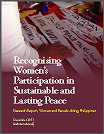November 26, 2008 was just another auspicious day in Chinese lunar calendar. Yet hundreds of jubilant guests and spectators congregated at the square, at the heart of the Zhoushan Village, Henan Province in Central China to witness an unusual wedding ceremony: The bride who was born and grew up in this village would receive her groom. The marriage ceremony would take place in her village. Once declared wife and husband, the newly married couple would live with the wife’s parents.
Despite the manifesto, “The Women are Equal with Men” in Chinese constitution and legislations since 1951, the patriarchy remains deeply-rooted in in many aspects of society, culture and people’s daily life, especially in the rural areas. No other occasion can vividly demonstrate and effectively perpetuate patriarchy than the traditional wedding ceremony which discriminates, devalues and oppresses girls and women.
A wedding is usually held in the groom’s village with a set of rituals that would disconnect the bride from her own family and their property. The wife moves out of her parent’s house to live with husband’s family as daughter-in-law, consequently loses her rights to land and heritage as a member of her own family and the indigenous rural community.
For this reason alone, the November wedding is more than a spectacle. It was a significant step away from a patriarchal practice and for girls and women, an unfair and uncertain future.
Today, more and more women activists in China are tracing imbalance of sexual ratio to the pervasiveness of discrimination against women and girls in Chinese culture and people's everyday lives.
The Henan Community Center for Education and Research (HCCER), a grassroots women organisation believes that such culture and its expression in daily practices can be changed. But real and effective transformation can only begin in the community, in the very contexts where forms of discrimination take place. Liang Jun, the director of HCCER and a supporter of the married couple, affirmed that customs like weddings are among the living traditions that ought to be transformed to ensure gender equality. This message was clearly articulated during the novel wedding. On each side of the stage where the couple exchanged vows were banners, bearing the messages: “Men respect women, women respect men; Men and women are equal” and “Men receive women [in marriage], Women receive men [in marriage]; Both are all right.”
Villagers remain amazed by this wedding, which somehow stirred their traditional partiality towards boys and men. “The daughter indeed can bring honour to her family and parents,” one observer said. HCCER vows to continue this kind of initiative that aims to transform discriminatory culture and conventions through publicity events, video production, and local theatre, among others.
*Liang Jun is the director of Henan Community Center for Education and Research, China.





 The
The 
 Isis Resource Center holds one of the largest feminist collections of materials in the Global South. With 40 years of publication experience, Isis holds a vast collection.
Isis Resource Center holds one of the largest feminist collections of materials in the Global South. With 40 years of publication experience, Isis holds a vast collection.